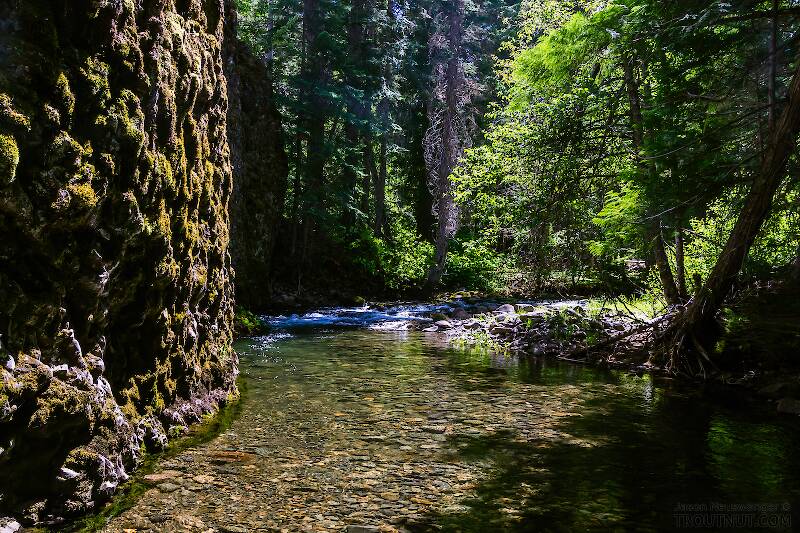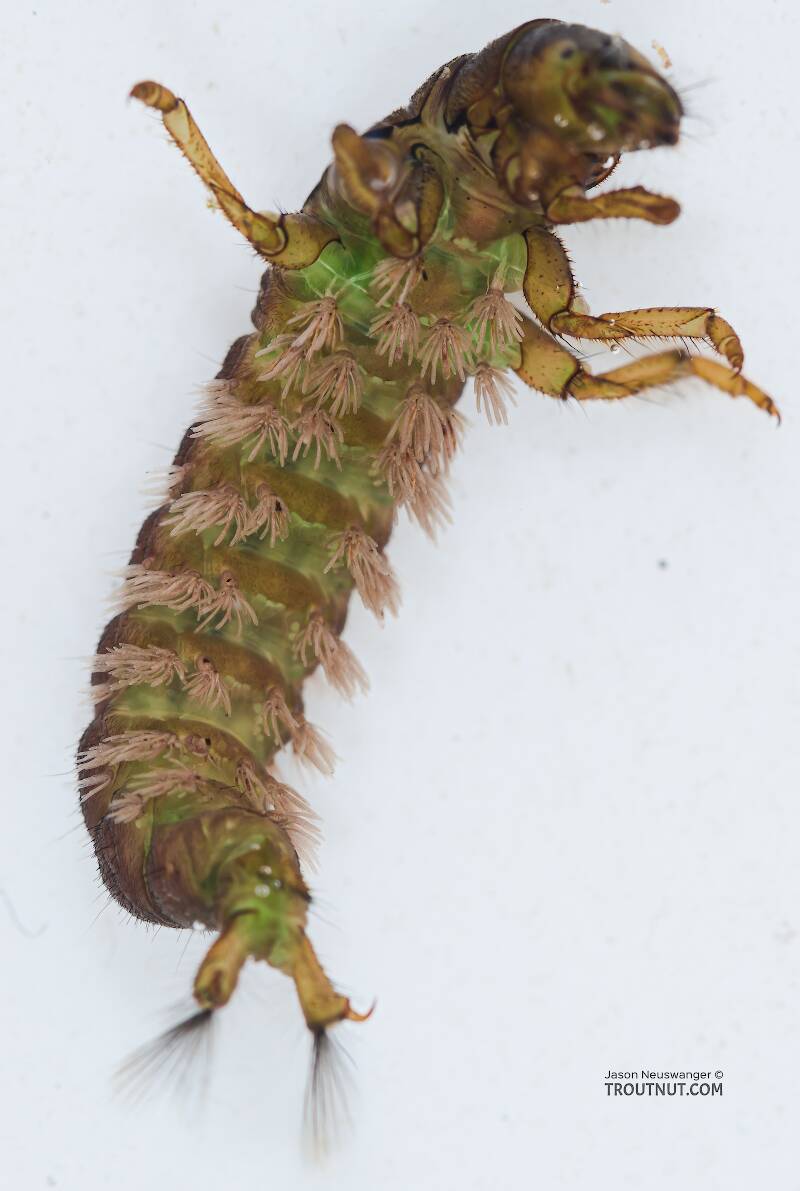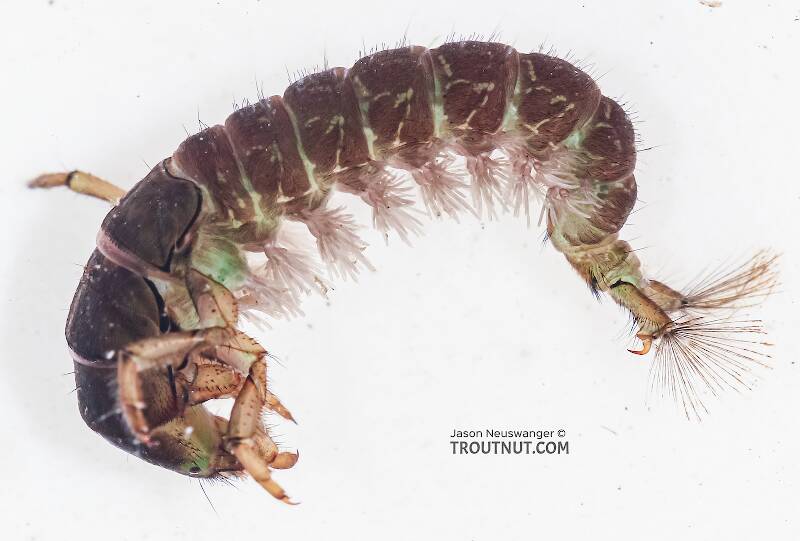
Salmonflies
Pteronarcys californica
The giant Salmonflies of the Western mountains are legendary for their proclivity to elicit consistent dry-fly action and ferocious strikes.
Featured on the forum

This is a striking caddis larva with an interesting color pattern on the head. Here are some characteristics I was able to see under the microscope, but could not easily expose for a picture:
- The prosternal horn is present.
- The mandible is clearly toothed, not formed into a uniform scraper blade.
- The seems to be only 2 major setae on the ventral edge of the hind femur.
- Chloride epithelia seem to be absent from the dorsal side of any abdominal segments.
Based on these characteristics and the ones more easily visible from the pictures, this seems to be Grammotaulius. The key's description of the case is spot-on: "Case cylindrical, made of longitudinally arranged sedge or similar leaves," as is the description of the markings on the head, "Dorsum of head light brownish yellow with numerous discrete, small, dark spots." The spot pattern on the head is a very good match to figure 19.312 of Merritt R.W., Cummins, K.W., and Berg, M.B. (2019). The species ID is based on Grammotaulius betteni being the only species of this genus known in Washington state.
- The prosternal horn is present.
- The mandible is clearly toothed, not formed into a uniform scraper blade.
- The seems to be only 2 major setae on the ventral edge of the hind femur.
- Chloride epithelia seem to be absent from the dorsal side of any abdominal segments.
Based on these characteristics and the ones more easily visible from the pictures, this seems to be Grammotaulius. The key's description of the case is spot-on: "Case cylindrical, made of longitudinally arranged sedge or similar leaves," as is the description of the markings on the head, "Dorsum of head light brownish yellow with numerous discrete, small, dark spots." The spot pattern on the head is a very good match to figure 19.312 of Merritt R.W., Cummins, K.W., and Berg, M.B. (2019). The species ID is based on Grammotaulius betteni being the only species of this genus known in Washington state.

Troutnut is a project started in 2003 by salmonid ecologist Jason "Troutnut" Neuswanger to help anglers and
fly tyers unabashedly embrace the entomological side of the sport. Learn more about Troutnut or
support the project for an enhanced experience here.
Caddisfly Genus Arctopsyche (Great Gray Spotted Sedges)
Arctopsyche grandis, the western species, is by far the most important in this genus. It produces excellent fishable hatches.
Genus Range
Larva & pupa biology
Diet: Smaller insects
Shelter type: They spin and tend their nets instead of building a case.
Specimens of the Caddisfly Genus Arctopsyche
2 Larvae
Discussions of Arctopsyche
Arctopsyche grandis in waterton canyon
1 replies
Posted by Krikut on May 16, 2016 in the species Arctopsyche grandis
Last reply on May 17, 2016 by Bnorikane
Discovered one of these guys or (gals?) back on March 20 of this year up in Waterton Canyon. He was so chunky I first thought it was a small hellgrammite (I grew up in Virginia, where the hellgrammite was the bug of choice in most smallmouth rivers). This particular one measured about half an inch and had a bright green tail/foot segment. I'm curious if you guys have a favorite immitation? Thanks!
Arctopsyche Grandis
6 replies
Posted by Epeorus on Jul 2, 2014
Last reply on Jul 6, 2014 by Entoman
A while ago there was some discussion of this bug in Colorado. I first came across this beast in early July 2011 on the Eagle River, just downstream of Edwards, Co. Met him again this week on the Eagle. It's quite the blast - big bugs and big trout. Especially the ones rising with abandon in the fast water in the middle of the day.
Funny thing is we don't seem to see these guys most years. The commonality between 2011 and this year is an extended runoff leading to cold and high - though clear water in early July. I wonder if they normally hatch during the peak of the runoff when no one is on the water.
I remember people commenting about these caddis allegedly being in parts of Colorado. The hatches the last two days on the Eagle and what I saw in 2011 would add some level of credence to that belief.
A size 10 (on a Partridge L3A) sponge body caddis with a dark gray body, and a size 10 Lafontaine sparkle emerger with a gray body and a clear shroud were the ticket.
Funny thing is we don't seem to see these guys most years. The commonality between 2011 and this year is an extended runoff leading to cold and high - though clear water in early July. I wonder if they normally hatch during the peak of the runoff when no one is on the water.
I remember people commenting about these caddis allegedly being in parts of Colorado. The hatches the last two days on the Eagle and what I saw in 2011 would add some level of credence to that belief.
A size 10 (on a Partridge L3A) sponge body caddis with a dark gray body, and a size 10 Lafontaine sparkle emerger with a gray body and a clear shroud were the ticket.
Arctopsyche grandis
6 replies
Posted by Flymonster on Sep 7, 2011 in the species Arctopsyche grandis
Last reply on May 20, 2013 by Flymonster
Here in the Willamette Valley the McKenzie Caddis (as Arctopsyche grandis is known locally) usually begins its emergence sometime around mid-May and can continue into mid-June. The most emergence activity will be noted on warm days once the water temperature reaches @ 52f. Most hatches occur on warm sunny days from 4pm-7pm. Arlen Thomason goes into great detail about the life-cycle and behaviors of a. grandis in his book "Bug Water".
At least for me, the McKenzie Caddis, marks the beginning of summer and excellent fly fishing for trout on the McKenzie, Middle Fork Willamette, North Fork of the Middle Fork Willamette, and our other local rivers and streams.
At least for me, the McKenzie Caddis, marks the beginning of summer and excellent fly fishing for trout on the McKenzie, Middle Fork Willamette, North Fork of the Middle Fork Willamette, and our other local rivers and streams.
Start a Discussion of Arctopsyche
References
- LaFontaine, Gary. 1981. Caddisflies. The Lyons Press.
- Merritt R.W., Cummins, K.W., and Berg, M.B. 2019. An Introduction to the Aquatic Insects of North America (Fifth Edition). Kendall/Hunt Publishing Company.
- Schwiebert, Ernest G. 1955. Matching the Hatch. MacMillan Publishing Company.
Caddisfly Genus Arctopsyche (Great Gray Spotted Sedges)
Taxonomy
Species in Arctopsyche: Arctopsyche grandis, Arctopsyche irrorata
2 species (Arctopsyche californica and Arctopsyche ladogensis) aren't included.



